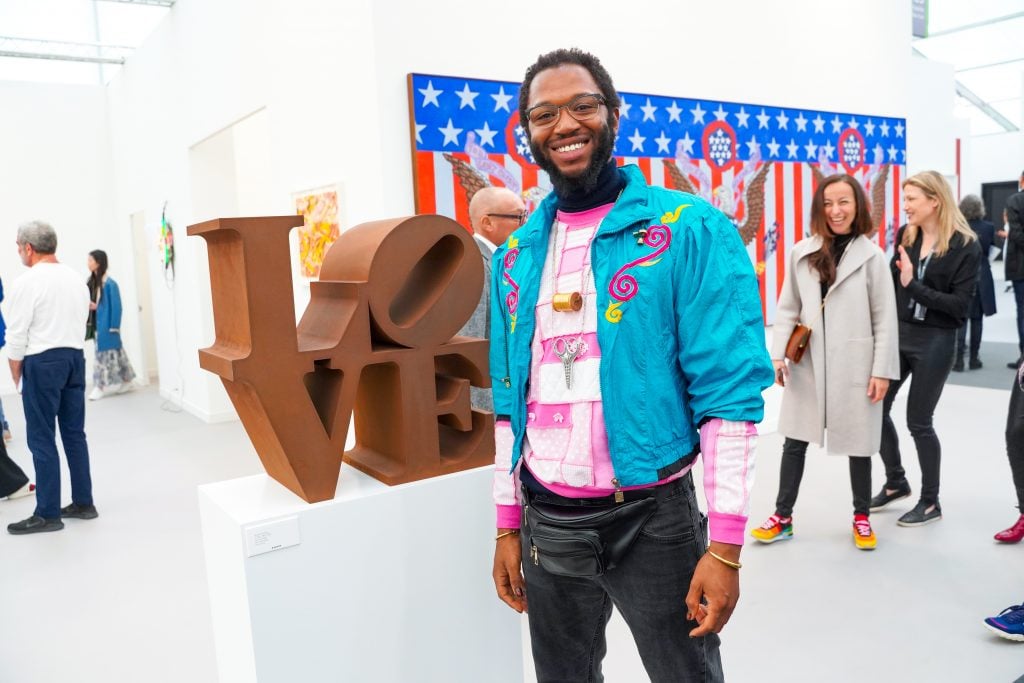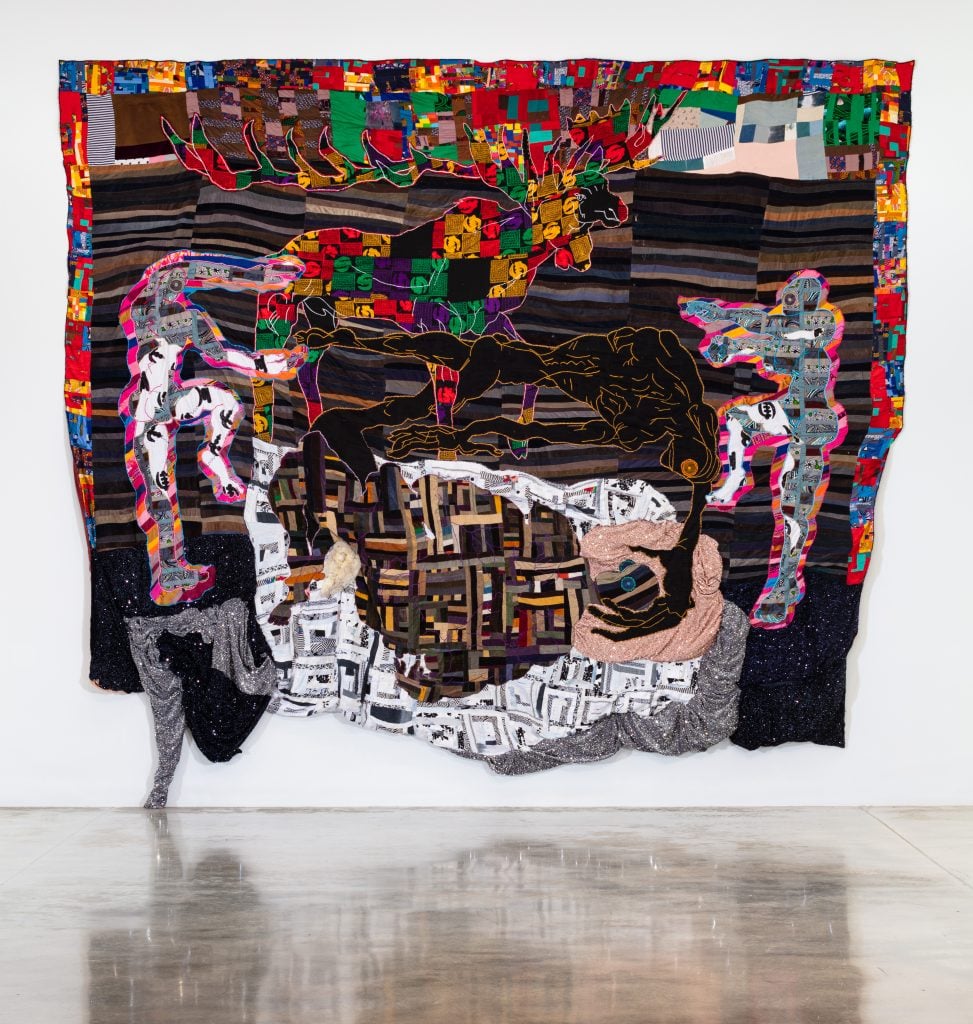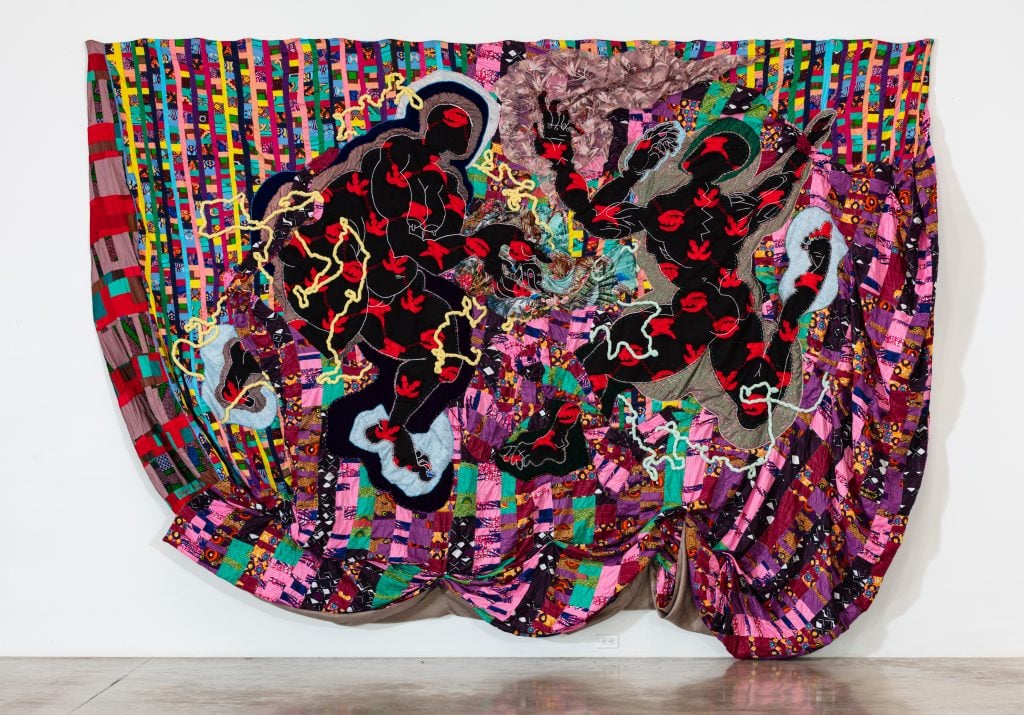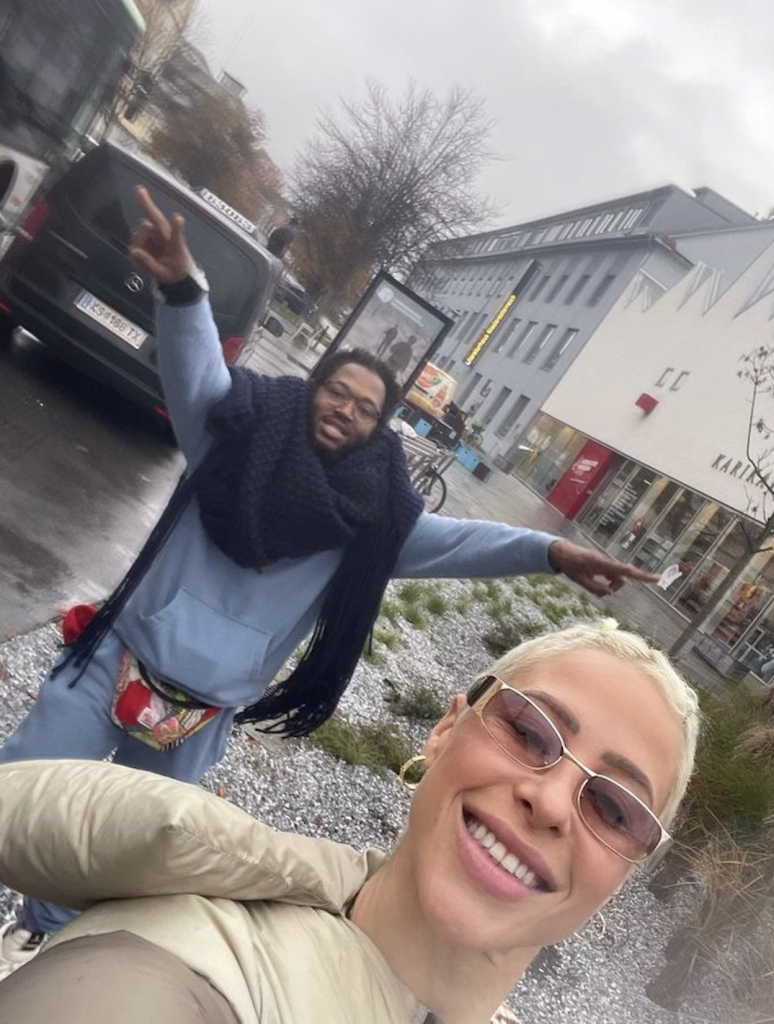Artists
Meet Basil Kincaid, the Artist-Quilter Making a Splash in Miami Beach
For the residency's twelfth year, the Rubell Museum leans into textile art.

For the residency's twelfth year, the Rubell Museum leans into textile art.

Annie Armstrong

Miami mega-patrons Don and Mera Rubell like to be thought of as tastemakers in the contemporary art world. Since they began an artist-in-residence program at their private institution, the Rubell Museum, in 2011, their emerging artist resident has been given the prime slot of the December show—timed to coincide with Art Basel Miami Beach. Among the art world, the spotlight has come to be known as a fast-track to art market stardom for the artist—sometimes a little too early for their comfort.
Basil Kincaid, who is this year’s resident, isn’t letting that pressure get to him. The market was already hot on his trail, as he has yet to secure formal gallery representation but has received a blue-chip stamp of approval, having been included Legacy Russell’s paradigm-shifting group show of textile-based artwork, “The New Bend,” at Hauser and Wirth this summer, off the heels of a solo exhibition at Venus Over Manhattan the year before. For now, he is leaving the handling of the market to Amir Shariat, who has now managed the Rubell’s artist-in-residence for the past five years.
For his debut at the museum, the 37-year-old artist has created three large-scale quilts, some of which have sculptural aspects that extend as far as a foot off of the base fabric, making them three-dimensional objects as well as wall-pieces.
“I’ve pushed the scale, the formal technique, and the dimensionality of all of these quilts,” he explained.
The vivid, multimedia works stretch over 20 feet long, and each one uses Kincaid’s personal symbolism to tell the story of himself, and the nine-generations of quilt makers he comes from in St. Louis, Missouri. Kincaid’s work builds on the tradition, though his pieces add a masculine dimension to the legacy, which had been upheld by the family matriarchs including his mother and grandmother.

Basil Kincaid, The Fields We Lay and Turn with Horns. Courtesy of the Rubell Museum.
Historically, the Rubell artist-in-residence has been a painter, or occasionally a sculptor. Kincaid is the first artist to present a full show in textile, though some still refer to the medium-bending works as paintings.
Kincaid refers to his pieces as embroidery, but he does base the works off of drawings, and gray-scale elements of the artworks refer to the pencils he works with.
Mera Rubell described the artist’s intense work ethic, displayed not only in the studio but in the physical training he holds himself to daily. “He has a very spiritual and physical work routine,” she said. “His artmaking is a beautiful complement to that, because these paintings take a lot of physical strength to make.”
The show has coincided with a rise in curatorial interest in textile art, and quilt making in particular. “The New Bend” hit a nerve critically this summer, and there has been a rising interest in the historical quilts coming out of Gee’s Bend, while contemporary quilts by Hank Willis Thomas, Faith Ringgold, and Sonya Clark continue to engage the art world.

Basil Kincaid, Courtship of Fireflies. Courtesy of the Rubell Museum.
The works feature recurring motifs of monsters, which Kincaid thinks of more so as protectors. “I’ve been thinking a lot about the nature of monstrosity,” he said. “What may seem like a monster to somebody else—well, maybe it’s good that it’s scary to some people because its meant to protect someone else.” When he used to draw pictures as a child, people often misunderstood the figures. “I remember my mom saying, ‘Why do you draw these creepy drawings?!’”, he recalled. “And the more I thought about that over time, I realized that while some people might see them as disturbing, they’re really my angels… who may seem scary to other people, but fight on our behalf.”
The largest piece in the show, Buttons in the Sky Bursting at the Seams, incorporates kente cloth, sequins, embroidery floss, repurposed curtains salvaged from around St. Louis. “That one looks at the spiritual journey of my life,” he said. “How did I get to be who I am, what I am? And capable of what I’m doing?”
Kincaid is aware that the Rubell residency is likely to come with a market boost, and how that can be a double-edged sword for an emerging artist who is still defining their practice.
“I don’t know exactly what I have to do to stop them from selling works at auction,” a former resident, Amoako Boafo, told Artnet News in 2020, just before his debut at the Rubell Museum. (Since that initial burst, Boafo’s market has stabilized, and he had a solo show at Gagosian in New York this past Spring.)

Basil Kincaid and Kennedy Yanko. Courtesy of Kennedy Yanko.
Kincaid has avoided engaging too much with his predecessors until now. “I plan to talk to the other residents once it’s all done,” he told me after I asked whether former residents had given him any advice. “I didn’t want to psych my experience up or down or in or out. I just wanted to go in there and make my art.”
That said, his good friend from home, artist Kennedy Yanko, just so happens to be another former Rubell resident. “Basil’s always been willing to take the path that leads him to better work, understanding the importance of experience and the living that has to happen to expand one’s practice,” she wrote over email. “As a result, he’s transformed his medium into new and modern material.”
Now on the other side of the residency, Kincaid speaks highly of his experience. It’s provided a new creative environment for Kincaid, who usually keeps a studio in Greater Accra, Ghana. “I’ve had to change my life in a number of ways. It’s been positive,” he said. “There’s such a wealth of knowledge here that you just can’t get anywhere else. You can spend years in the library and never have the direct art historical knowledge [the Rubells] have. They’ve been spending their whole life in this.”
While speaking about the work he’s been able to make during his residency, Kincaid choked up a few times. “I went all in on the art and allowed myself to prioritize it over everything else,” he said. “I feel like with art, for me at least, the specificity of it is what opens the gates to a universality. I may be dealing with some very personal issues or experiences, but then I get to talking about the art with other people and I come into these unexpected scenarios where other people have gone through those feelings. That’s really reaffirming.”
Time will tell how Kincaid’s stint at the Rubell Museum will impact his career, but how the exhibition is received by the art world in Miami this week as collectors, curators, and critics flock to 23rd Street to see the works, will certainly count for a lot.
More Trending Stories:
Art Critic Jerry Saltz Gets Into an Online Skirmish With A.I. Superstar Refik Anadol
The Old Masters of Comedy: See the Hidden Jokes in 5 Dutch Artworks
A Royal Portrait by Diego Velázquez Heads to Auction for the First Time in Half a Century
How Do You Make $191,000 From a $4 Painting? You Don’t
In Her L.A. Debut, South Korean Artist Guimi You Taps Into the Sublimity of Everyday Life
Two Rare Paintings by Sienese Master Pietro Lorenzetti Come to Light After a Century in Obscurity